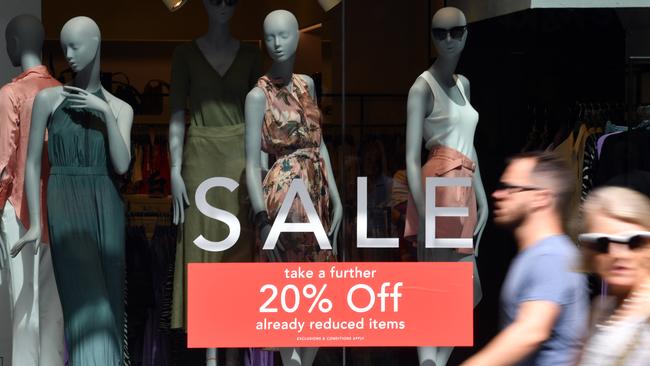Retail suffers worst growth since 1991 recession
Retail is enduring the worst conditions in almost 30 years and looks set to drag on already-weak growth.

Australia’s retail sector is experiencing its worst growth since the 1991 recession, and the soft activity is likely to provide a further drag on economic growth, which has already slumped to its slowest pace since the global financial crisis.
According to the Australian Bureau of Statistics, retail sales in the second quarter rose just 0.2 per cent. That was after recording a 0.1 per cent fall over the three months through March.
The weaker-than-anticipated retails sales leave annual growth in turnover up just 0.2 per cent over the year — the worst result since 1991.
“We are near a retail recession,” UBS analyst George Tharenou said.
He said with car sales falling about 3 per cent over the quarter, household consumption — which accounts for 60 per cent of the country’s economic growth — would likely contract to its slowest pace since the global financial crisis.
Mr Tharenou said he expected Australia’s GDP growth to slow to 1.4 per cent over the year through June — the data will be released in September — down from a rate of 1.8 per cent in March. The March quarter figures were already the slowest since the GFC.
In June, the Reserve Bank of Australia cut official interest rates for the first time since 2016. The drop in the cash rate to 1.25 per cent was followed by a cut in July to a record-low 1.00 per cent, as policy makers became concerned about a sharp slowdown in the economy led by a retreat in consumer demand.
Flat wages growth and record household debt are expected to continue to weigh on consumer confidence, with the RBA Governor Philip Lowe saying last week that further interest rate cuts are possible.
“Hence, this reinforces our view the RBA will likely materially downgrade their outlook again next week, with a dovish tilt amid trade wars escalating,” Mr Tharenou said.
Up-market retailer David Jones yesterday cast a pall over the nation’s retail sector on the eve of reporting season after its owner, South Africa’s Woolworths Holdings, declared Australian retail is in recession as it slashed $437 million in value from the chain. The David Jones owner warned its business in Australia was under “unprecedented economic pressures”, with more than $1.1 billion in carrying value now torched in five years.
Over the month of June, the ABS said retail sales rose 0.4 per cent. This was led by a 2 per cent rise in clothing sales, the strongest increase since October 2018. Still, department store sales fell by 0.6 per cent, the third decline in four months.
BIS Oxford chief economist Dr Sarah Hunter said it was yet more gloomy news for already struggling business owners.
“With volumes rising this means the sector doesn’t meet the usual recession criteria … (but) it suggests that we’ll see another weak print for consumer spending in the June quarter national accounts,” Dr Hunter said.
Indeed.com APAC economist Callam Pickering said it had been nearly 30 years since retail volume growth was this weak, with household spending unlikely to contribute much to real GDP growth in the June quarter.
“Retailers are struggling to push goods out the door,” Mr Pickering said.
“The retail sector isn’t as important as it once was, due to the rise of the service sector, but it speaks volumes about the struggle for households across the country.”
The outlook isn’t all bad, Mr Pickering added, with lower interest rates, a minimum-wage increase, and the federal government’s tax offsets set to free up a little cash for Australian households.
“(But) without a sustained pick-up in wage growth, factors such as tax cuts and lower rates will provide little more than a sugar hit for the retail sector,” he said.
With AAP




To join the conversation, please log in. Don't have an account? Register
Join the conversation, you are commenting as Logout